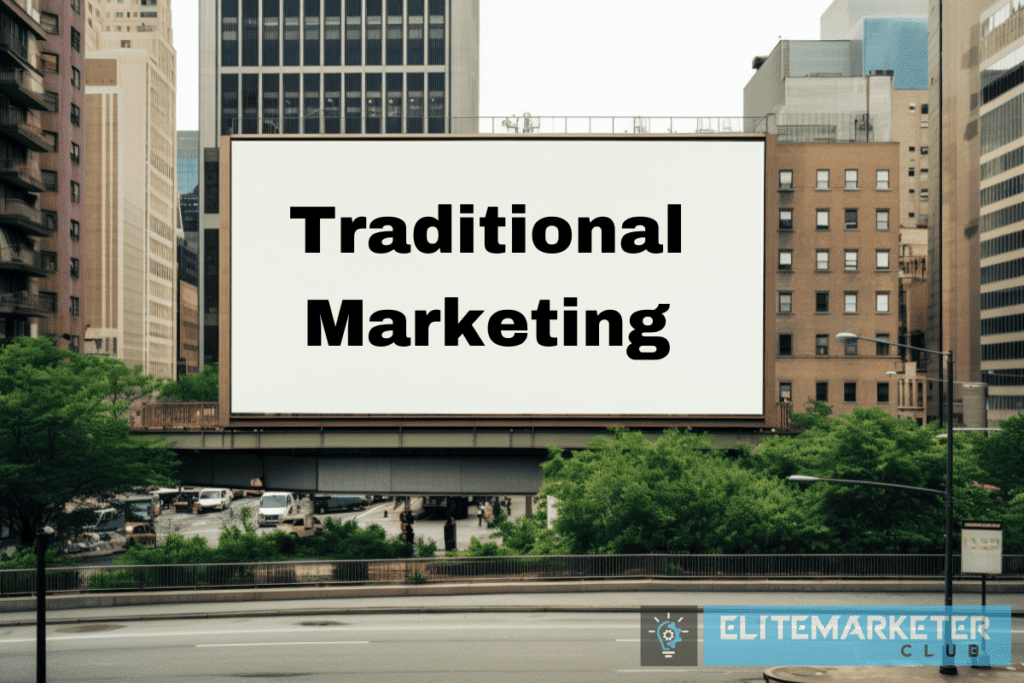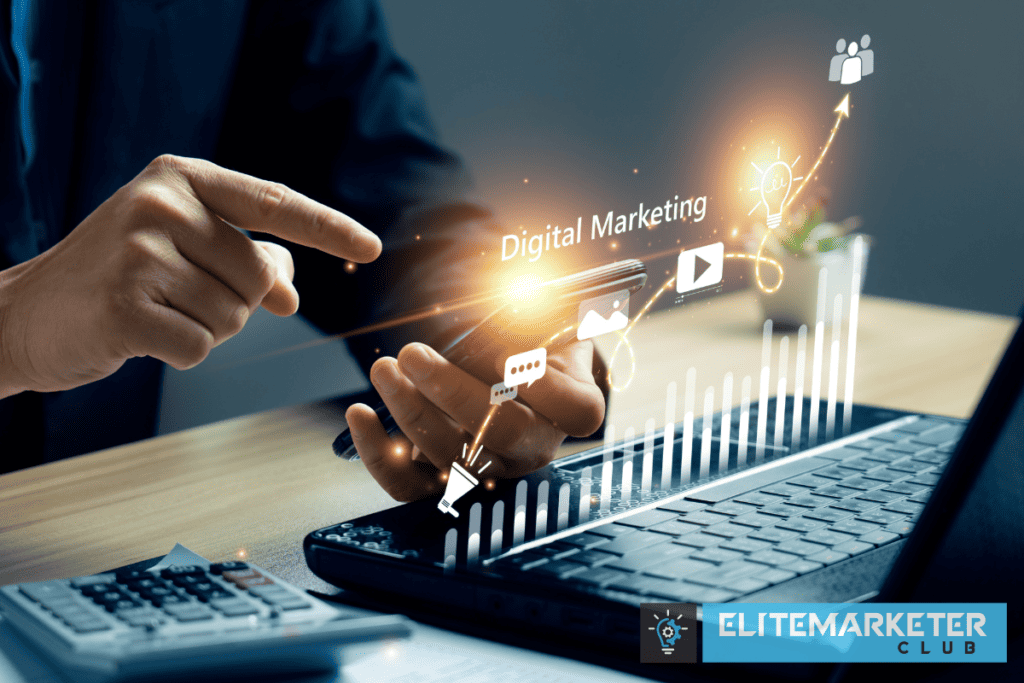Traditional Marketing vs. Digital Marketing: Understanding the Key Differences
Traditional Marketing vs. Digital Marketing – A Comprehensive Analysis
When we compare Traditional Marketing vs. Digital Marketing, traditional marketing encompasses promotional tactics used to advertise products and services for decades before the digital age. Methods like television, radio, magazine ads, billboards, events, and trade show booths fall into the traditional bucket.
In contrast, digital marketing leverages the internet, mobile devices, and social media to connect with consumers. This includes marketing strategies like:
- Search Engine Optimization (SEO)
- Pay Per Click (PPC) search and display advertising
- Social media marketing campaigns
- Email marketing
- Content marketing – blogs, videos, podcasts
- Affiliate partnerships and influencer collaborations
Traditional and digital marketing platforms have advantages and disadvantages in today’s business world. This comprehensive guide will compare the two frameworks across crucial factors like targeting capabilities, costs, ROI measurements, etc. We’ll also be sure to provide actionable recommendations on when each strategy excels based on your overarching marketing objectives and target audience attributes.
Overview of Traditional Marketing Methods
Brands have utilized traditional promotional mix elements like print, broadcast, and direct mail advertising for decades. Common examples include:
- Newspaper and magazine advertisements – Full-page ads, coupons, and inserts remain the go-to. According to Pew Research, U.S. weekday paper circulation was 24 million in 2020.
- Broadcast ads on radio and TV – 30-second audio jingles or video commercials shared on local stations and national networks. Per Statista, the radio industry generated $14 billion in 2021.
- Direct mail campaigns – Physical catalogs, postcards, and sales flyers are sent to target buyer mailing lists. Around 44% of Americans still use direct mail.
- Billboards – Roadside ad displays come in standard or digital interactive formats. The industry accounted for $7 billion in revenue last year.
- Telemarketing calls – Sales reps interact directly via phone. U.S. teleservices yearly revenues exceed $4 billion.
- Trade shows and events – Brands host or exhibit products at conferences and seminars. The global trade show market value will hit $138 billion by 2031.
Here is the next section on the benefits of traditional marketing:
Benefits of Traditional Marketing
While digital saturation grows yearly, traditional promotional mediums retain unique advantages that still make them viable for brands today:
- High visibility for broad audience reach – TV and radio spots alongside roadside billboards allow brands to display ads to large geographic areas rather than just targeted buyer groups. For mass awareness of a new product, traditional broadcasts excel. Magazines and trade shows also drive exposure. Per Forbes, 89% still discover new products in stores with displays.
- Consumer familiarity and trust – Shoppers are comfortable with long-utilized traditional formats compared to internet ads, which only gained prominence post-2000. Direct mail also allows personalized customer messaging. Consumers find TV and print ads more trustworthy than digital channels.
- Physical collateral and consistent visibility – Billboards, in-store displays, and posters offer constant visual reminders. Trade show giveaways provide takeaway items reiterating messages. Digital lacks the same physical permanence if the hardware needs rebooting. Per Global Digital Marketing Research, 70% of attending shows had more confidence in exhibitors.

Drawbacks and Limitations of Traditional Methods
Though traditional advertising mediums have merits, they pose notable downsides like:
- Inefficiency in reaching targeted groups – Broad TV, radio, and print ads run to entire viewing areas rather than precise demographics. Per Insider Intelligence, only 40% find TV ads relevant. Lack of customization means the budget gets wasted marketing to disinterested consumers.
- **Inflexibility adapting to change ** – Print ads lock in layouts and messaging for magazine issue cycles rather than adjusting in real-time. TV/radio slots must air completely despite tuning out. Conversely, digital platforms like PPC ads can pivot creatives or targets in minutes based on performance.
- Difficulty tracking direct response – Measurements center on imprecise impressions or reach rather than clicks/conversions. Billboard viewership relies on traffic estimations and surveys. Digital offers concrete analytics like pay-per-click and email open rates.
- Higher cost and barriers to entry – Broadcast/print ad buying relies on media agencies. Minimum spends are thousands for national airtime or full-page magazine pages. Trade show participation also demands significant display investments. Competitively priced digital ads have lower barriers for small businesses with any budget.
Rise of Digital Marketing Overview
Digital marketing and traditional marketing saw hockey stick growth in adoption and effectiveness as internet and mobile device penetration expanded exponentially:
- As smartphone ownership grew from 35% in 2011 to 85% by 2022 in the U.S., marketers migrated budget to online channels.
- eMarketer predicts 65% of total ad spend will flow toward digital tactics in 2022 compared to just 33% in 2015.
- Advancements in data and targeting propelled digital marketing as brands could track conversions directly while tailoring messaging to different buyer personas.
- Platforms like Google and Meta (formerly Facebook) introduced sophisticated advertising options combining display, video, and search under unified dashboards.
- Automation technology enabled triggers like retargeting site visitors or emailing subscribers to streamline outreach.
- Consumers shifted their online engagement, researching products digitally and adopting streaming over linear television.
Unlike traditional broadcasts for broad exposure, digital channels allow narrow targeting of ideal buyer demographics and interests. Common digital marketing categories include:
- Search Engine Optimization (SEO) – Optimizing website content to achieve higher unpaid/organic rankings in search engines like Google. Key tactics include keyword research, site speed improvements, and backlink building.
- Pay-Per-Click Advertising – Purchasing text or display ads through platforms like Google Ads and Microsoft Advertising based on cost-per-click vs impressions.
- Social Media Marketing – Creating content and running ad campaigns on networks like Facebook, Instagram, Twitter, YouTube, and TikTok. It aligns with increasing global social media usage, which reached over 3.7 billion in 2021.
- Affiliate Marketing – Partner with relevant blogs, influencers, and publishers to promote products. Commissions apply when referrals drive actions. By next year, spending on affiliates will climb to $8.2 billion.
Benefits and Strengths of Digital Marketing
Digital advertising platforms offer unique upsides to traditional formats struggle to match, like:
- Cost efficiency at scale – Large networks like Google and Meta leverage millions of advertisers across cheap ad unit costs for efficiency. Auction-based pricing keeps CPC rates affordable vs high TV/print minimums. Geo-targeting also ensures smaller location-based campaigns waste no budget on irrelevant areas.
- Unparalleled targeting capabilities – Granular demographic, interest, behavioral, and remarketing options allow perfectly aligned messaging. Brands engage the most qualified prospects already seeking solutions vs. interrupting disinterested consumers. Contextual options go beyond search keywords to webpage content.
- Measurable campaign performance – Digital marketing is quantifiable with tracked metrics like impressions, clicks, conversions, email open rates, and more. Precise ROI appraisal across channels guides optimal budget allocations. Multi-touch attribution even follows customer journeys across devices.
- Higher engagement rates – Users voluntarily click and view ads matching their intent rather than disrupting content. Per Facebook, click-through rates for native social ads are 6X higher than standard formats.

Drawbacks and Weaknesses of Digital Marketing Methods
For all the strengths of digital advertising, potential weaknesses pose challenges:
- Screen fatigue from excessive device use – The average American spends almost 8 hours daily on phones and computers. Constant connectivity causes stress dubbed “digital burnout syndrome.” Too many ads contribute to fatigue and banner blindness browsing.
- Rapidly evolving platforms and algorithms – Marketers scramble to adjust to regular changes across Google, Facebook, and Amazon, influencing reach. Suddenly, vanishing YouTube video views or tanking Facebook engagement leave strategy in flux.
- Ad saturation and rising costs – Billions now get spent on digital ads annually, flooding space and bidding up costs. Google click costs jumped from $1.32 in 2012 to over $2 by 2022. More competition exists, vying for audience attention.
- Technical expertise barriers – Digital marketing relies on funnel optimization, analytics proficiency, tag management familiarity, and ad platform learning curves. Constant education consumes resources. Traditional advertising requires conceptual message creation.
- Vulnerabilities like cyber attacks – Hacking, theft, and platform outages cause massive campaign disruptions. Technical dependencies increase security risks absent with print or TV reliance.
Key Metrics to Compare Marketing Methods
When weighing traditional vs digital campaigns, crucial performance indicators guide strategy:
- Cost Per Acquisition/Action (CPA) – Fixed cost to acquire a conversion like a sale, email signup, or app install. Digital CPAs can calculate precisely from tracked actions, while traditional CPAs use a broader impression or audience reach proxies.
- Click-Through-Rates (CTR) – Percentage of impressions delivered that receive clicks. Shows message relevance and quality. Higher CTRs signal positive engagement. Digital ads again have direct measurement, while traditional use sampled exposure data.
- Lead Generation Rates – Speed and volume of prospect contact info captured is essential for sales funnel velocity. With manual effort, digital forms and landing pages easily capture more leads than traditional trade shows.
- Sales Velocity From Market Spend – The speed at which advertising activity converts into revenue provides solid ROI interpretation and informs optimal budget distribution. Digital offers multi-touch attribution, while traditional correlations are estimated.
- Return on Ad Spend (ROAS) – Direct revenue or margin gains minus promotional costs. Benchmarks vary vertically. Digital analyses granular transaction data to calculate accurate ROAS by channel. Traditional uses proxy sales response rates after campaigns.

When Traditional Marketing Excels
Though the digital shift continues, traditional advertising maintains strengths in these scenarios:
- Broad brand awareness goals – Mass media broadcast builds rapid visibility most efficiently for announcing a new product line nationwide. A CEO calling TV “unmatched” for brand building aligns with Nielsen data showing 92% still watch weekly.
- Reaching specific demographics – TV programming neatly aligns audiences by age brackets, income levels, and interests. News skews older while sports indexes are more male. Traditional media still outperforms digital-consuming adults over 50 years of age. That matters for healthcare or finance verticals.
- Promoting consumer product goods (CPGs) – Traditional venues like grocery aisles, billboards, and local broadcasts frequently surround shoppers. One study saw a 13% lift in purchases from combining TV and print food ads. Digital lacks the physical immediacy and sensory aspects of traditional formats.
- Rural or isolated markets – Traditional channels drive broader exposure for geographic areas with limited internet connectivity and adoption. Per Pew, 30% of rural adults never use the internet. Just 16% are on social platforms. TV and radio suit rustic product promotions.
When To Use Digital Marketing
While traditional advertising retains strengths for awareness, digital trumps for precision targeting crucial for direct response:
- Laser-focused targeting – No traditional channels match the meticulous demographic customization of digital. Platforms like Google and Facebook leverage billions of data points for aligning B2B ads to company attributes or B2C ads towards buyer lifestyle indicators predictive of conversions.
- Performance optimization agility – Unlike fixed print production cycles, digital creatives refine their work based on real-time metrics to raise engagement and lower CPA. Continual split testing evaluates message alternatives. Attribution tracks multi-channel synergies between search, social, referrals, and email.
- Lower minimum budget requirements – Digital levels the playing field for smaller businesses priced out of national TV/radio. Local advertisers also avoid wasting geographic ad buys. Granular geo-targeting eliminates irrelevant impressions that bloat traditional CPM costs.
- Younger tech-savvy audiences – Digital dominates millennial and Gen Z attention, especially on mobile devices. Younger generations rely extensively on sites like Amazon for research before purchases. Traditional channels skew towards older age groups. Align channel selection with target market age.
- Measurable direct response – No traditional format tracks conversions directly. Digital offers precise ROI appraisal down to the keyword driving each sale on Google Ads or the influencer post spawning an affiliate purchase. KPI dashboards centralize analytics for optimization.
Conclusion and Takeaways
In closing, while digital marketing grows exponentially, traditional tactics still warrant brands’ consideration today in the proper contexts:
- There is no definitive “better” option between traditional and digital advertising. Instead, align channel selections strategically based on campaign goals, product categories, demographic targets, geographic needs, and budget realities.
- Combining traditional and digital creates an “omni-channel” approach leveraging the unique strengths of each. Holistic strategies fuse mass awareness from TV with precision conversions from performance ads.
- As costs per digital engagement/action continue rising, reevaluating portions of the budget for traditional outlets balances overall efficiency. Hybrid strategies hedge bets against sole digital dependency.
- Still, the long-term trajectory shows digital assuming a more significant share as connectivity expands globally. Marketers merely need to apply advanced analytics to attribute touchpoints and interpret behavioral data for insights.
- With innovations like streaming/addressable TV blurring lines between digital and traditional, the focus moves from ad format to audience quality and precision. Data-driven targeting nullifies the channel itself.
In a fragmented media landscape, brands must eschew a rigid “either/or” mentality, pitting traditional against digital advertising. Custom blending media buys based on audience metrics and sales impact ultimately wins.
That concludes this comprehensive guide comparing traditional and digital marketing across targeting capabilities, performance tracking, costs, use cases, and more.
Frequently Asked Questions
Q: What is the difference between traditional marketing and digital marketing?
A: Traditional marketing refers to any marketing that isn’t online, such as print, direct mail, broadcast, or telephone. Digital marketing, on the other hand, involves promoting products or services through digital channels like search engines, websites, social media, email, and mobile apps.
Q: What are the pros and cons of traditional marketing?
A: The pros of traditional marketing include reaching local audiences effectively through print and broadcast media. However, some cons include limited reach and often higher costs than digital marketing strategies.
Q: What are the pros and cons of digital marketing?
A: The pros of digital marketing include global reach, targeted audience segmentation, and cost-effectiveness. Conversely, cons may include ad fraud, privacy concerns, and the potential for information overload.
Q: What are some forms of traditional marketing?
A: Forms of traditional marketing include print ads, television commercials, radio advertisements, direct mail, billboards, and cold calling.
Q: What are some forms of digital marketing?
A: Digital marketing encompasses various forms, such as social media marketing, content marketing, email marketing, search engine optimization (SEO), pay-per-click (PPC) advertising, and affiliate marketing.
Q: How do traditional marketing strategies differ from digital marketing strategies?
A: Traditional marketing strategies often rely on one-way communication and mass media, while digital marketing strategies focus on two-way communication, personalized messaging, and leveraging data and analytics.
Q: What is the impact of traditional marketing in the modern era?
A: Traditional marketing still holds value in reaching specific local audiences and can complement digital efforts, but its impact is diminishing in comparison to the reach and effectiveness of digital marketing channels.
Q: What role do marketing channels play in traditional and digital marketing?
A: Marketing channels are how a business delivers a product or service to its customers. In traditional marketing, channels may include newspapers, magazines, TV, and direct mail, while in digital marketing, they encompass websites, social media, email, and mobile apps.
Q: How do traditional and digital marketing differ regarding the target audience?
A: Traditional marketing often targets local and broad audiences, while digital marketing allows for precise targeting based on demographic, behavioral, and psychographic data, resulting in more personalized and relevant messaging to the audience.
Q: What’s the difference between traditional and digital marketing in terms of effectiveness?
A: Traditional marketing is often effective in reaching specific local audiences, but digital marketing offers broader reach, precise audience targeting, real-time analytics, and the ability to engage and interact with the audience, making it more effective in many cases.

